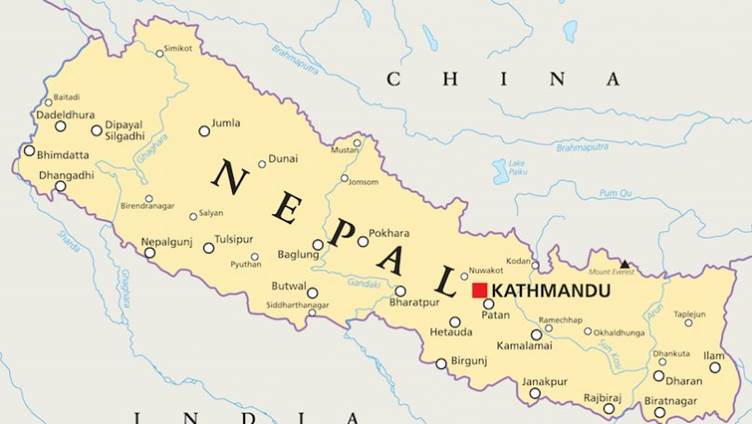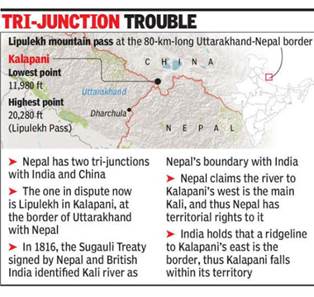BORDER MANAGEMENT BETWEEN INDIA AND NEPAL

Copyright infringement is not intended
Context:
- The 12thIndia-Nepal Joint Working Group (JWG), which discusses several issues related to Border Management and security matters, was held in New Delhi.
- The two sides reviewed the decisions taken in the last JWG held on February 10 -11, 2015 in Pokhara, Nepal.
- They also deliberated on issues related to trans-border criminal activities, strengthening of border infrastructure, empowerment and capacity building of various security-related institutions, and preventing/curbing terrorist and criminal activities amongst others.
- The Joint Working Group reviewed the Border District Coordination Committee (BDCC) meetings held earlier and also the progress made on the signing of the Mutual Legal Assistance Treaty, Extradition Treaty and other outstanding MoUs to be signed between the two sides.
Lipulekh Pass:
- Nepal's former Prime Minister pledged to "take back" the territories of Kalapani, Limpiyadhura and Lipulekh from India through dialogue if his party comes back to power.
- It is a far western point near Kalapani, a disputed border area between Nepal and India. Both India and Nepal claim Kalapani as an integral part of their territory — India as part of Uttarakhand's Pithoragarh district and Nepal as part of Dharchula district.
- Nepal came out with a new map showing Lipulekh, Kalapani and Limpiyadhura as its territories.
- India reacted sharply, calling it a "unilateral act" and cautioning that such "artificial enlargement" of territorial claims will not be acceptable to it.

Copyright infringement is not intended
What are the challenges in India-Nepal relations?
- Nepali nationalism and Anti-India sentiments: Anti-India Sentiment in Nepal is largely politically motivated as it is wrongly perceived as India’s backing to Monarchy.
- Madhesi’s section of People lives throughout the southern part of the Terai region and has much closer ties with India. Nepal government accused India of supporting Madhesi’s and stated India is interfering in the internal matters of Nepal.
- China’s closeness with Nepal and the Influence of China in India-Nepal relations is a cause of concern. Nepal has drifted away from India's influence, and China has gradually filled the space with investments, aid and loans. China considers Nepal a key partner in its Belt and Road Initiative.
- About 1850 km boundary line between India-Nepal faces two major boundary disputes.
- Kalapani dispute: Kalapani is the disputed territory in the Uttarakhand state of India. The British government has set the origin of River Kali as the western border of Nepal. But the origin of the river Kali is disputed between India-Nepal. While India uses the newer British survey, Nepal wants the area to be demarcated based on the older British survey.
- Susta Dispute: Susta is another disputed territory located in the Terai regions of India.
- The border is notoriously porous. Being provided special status to Nepal, India’s internal security faced many challenges such as
- The Pakistani militants using Nepalese territory as a hideout and base for infiltration into India.
- The Nepalese Maoists have extended support and cooperation to the Indian Maoists.
- Pumping fake Indian currency notes, human trafficking especially young girls and women, cattle smuggling, etc.
India’s importance to Nepal:
- India is the nearest foreign employer to Nepali Citizens, which provides various avenues of work and ease in assimilation into a foreign culture.
- Nepal’s reluctance to Mandarin has overturned several Nepali students into Indian universities.
- India is the only potential neighbour who could harness Nepal’s hydropower.
- Moreover, Indian tourists are the major movers of Nepal’s tourism sector.
- As close neighbors, India and Nepal share unique ties of friendship and cooperation characterized by an open border and deep-rooted people-to-people contacts of kinship and culture.
Nepal’s relations with India and China in recent times:
- There is an increasing tendency among Nepalese politicians to use anti-India rhetoric as also push their two powerful neighbours in covert manoeuvres for domestic political gains.
- India’s entrenched interests in Nepal suffered a setback in 2015, when a blockade at the borders ensued following protests by Madhesis and some other ethnic groups against marginalisation of their interests in the newly-passed Nepalese Constitution.
- The blockade, which Nepal accused India of facilitating, caused a humanitarian crisis in the landlocked country.
- Within a month of the lifting of the blockade, Oli visited Beijing and signed a transit agreement that included access to Chinese ports and construction of rail links between the two countries.
- This signalled a scaling down of Nepal’s heavy dependence on India.
- China has been a big factor in Nepal’s internal politics since 2006. China has also invested in crucial sectors like trade and Investment, energy, tourism and post-earthquake reconstruction, and is Nepal’s biggest FDI contributor.
Background of relations:
- As close neighbors, India and Nepal share unique ties of friendship and cooperation characterized by an open border and deep-rooted people-to-people contacts of kinship and culture.
- There has been a long tradition of free movement of people across the border. Nepal shares a border of over 1850 km with five Indian states – Sikkim, West Bengal, Bihar, Uttar Pradesh and Uttarakhand.
- The India-Nepal Treaty of Peace and Friendship of 1950 forms the bedrock of the special relations that exist between India and Nepal. Nepalese citizens avail facilities and opportunities on par with Indian citizens in accordance with the provisions of the Treaty.
- Nearly 8 million Nepalese citizens live and work in India.
- Nepal is a unique country whose citizens can enrol into the Indian civil services as also the Army, which bestows an honorary General’s title to the Nepal Army Chief, a gesture that is reciprocated in equal terms.
- There are regular exchanges of high-level visits and interactions between India and Nepal.
- India and Nepal have several bilateral institutional dialogue mechanisms, including the India Nepal Joint Commission co-chaired by External Affairs Minister of India and Foreign Minister of Nepal.
- DEFENCE COOPERATION
- India has been assisting the Nepal Army (NA) in its modernisation by supplying equipment and providing training.
- Assistance during disasters, joint military exercises, adventure activities and bilateral visits are other aspects of India’s defence cooperation with Nepal.
- A number of defence personnel from Nepal Army attend training courses in various Indian Army training institutions.
- The ‘Indo-Nepal Battalion-level Joint Military Exercise SURYA KIRAN’ is conducted alternately in India and in Nepal.
- The Gorkha regiments of the Indian Army are raised partly by recruitment from hill districts of Nepal.
- 2015 EARTHQUAKE IN NEPAL
- Government of India swiftly dispatched National Disaster Response Force (NDRF) teams and special aircrafts with rescue and relief materials to Nepal.
- The total Indian relief assistance to Nepal amounted to over US$ 67 million.
- The Government of India announced a post-earthquake reconstruction package of US$ 1 billion (which comprises US$ 250 million grant and US$ 750 million concessional Line of Credit)
- CONNECTIVITY AND DEVELOPMENT PARTNERSHIP
- Government of India’s development assistance to Nepal is a broad-based programme focusing on creation of infrastructure at the grass-roots level, under which various projects have been implemented in the areas of infrastructure, health, water resources, education and rural & community development.
- In recent years, India has been assisting Nepal in development of border infrastructure in the Terai area; development of cross-border rail links at Jogbani-Biratnagar, Jaynagar-Bardibas; and establishment of Integrated Check Posts at Birgunj, Biratnagar, Bhairahawa, and Nepalgunj.
- The total economic assistance earmarked under ‘Aid to Nepal’ budget in FY 2019-20 was INR 1200 crore.
- Apart from grant assistance, Government of India has extended Lines of Credit of USD 1.65 billion for undertaking development of infrastructure.
- ‘India-Nepal New Partnership in Agriculture’ was launched in 2018.
- WATER RESOURCES COOPERATION
- A three-tier bilateral mechanism established in 2008, to discuss issues relating to cooperation in water resources, flood management, inundation and hydropower between the two countries, has been working well.
- ENERGY COOPERATION
- India and Nepal have a Power Exchange Agreement since 1971 for meeting the power requirements in the border areas of the two countries, taking advantage of each other's transmission infrastructure.
- India is currently supplying a total of about 600 MW of power to Nepal.
- An Agreement on ‘Electric Power Trade, Cross-border Transmission Interconnection and Grid Connectivity’ between India and Nepal was signed in 2014.
- South Asia’s first cross-border petroleum products pipeline connecting Motihari in India to Amlekhgunj in Nepal was inaugurated in
- ECONOMIC
- India is the largest trading partner of Nepal.
- Total bilateral trade in 2018-19 reached INR 57,858 cr.
- In 2018-19, while Nepal’s exports to India stood at INR 3558 cr, India’s exports to Nepal were INR 54,300 cr.
- Indian firms are among the largest investors in Nepal, accounting for more than 30% of the total approved foreign direct investments.
- EDUCATION AND CULTURE
- GoI provides around 3000 scholarships/seats annually to Nepalese nationals for various courses at the Ph.D/Masters, Bachelors and plus–two levels in India and in Nepal.
- GoI initiatives to promote people-to-people contacts in the fields of art & culture, academics and media include cultural programmes, symposia and events organized in partnership with different local bodies of Nepal, as well as conferences and seminars in Hindi.
- INDIAN COMMUNITY
- Around 6,00,000 Indians are living/domiciled in Nepal.
- These include businessmen and traders who have been living in Nepal for a long time, professionals (doctors, engineers, IT personnel) and labourers (including seasonal/migratory in the construction sector).
Way Forward:
- The Kalapani dispute must be resolved expeditiously and earnestly, to the mutual satisfaction of both sides.
- A Joint Boundary Demarcation Committee could be appointed by both the countries to scientifically study the Maps and come to a conclusion diplomatically.
- India must introduce new economic, developmental and infrastructure initiatives with Nepal that will not only bring tangible benefits to Nepali citizens but also address the vulnerabilities that will emerge in Nepal as the country engages with China.
- A prudent course for India would be to let Nepal cope with its internal political mess. India must encourage consolidation of a people-driven polity, and improve its own popular profile.
- Nepal has asked for a revision of the 1950 treaty, and this has been accepted by India. Work should begin in this direction.
- On trade and investment issues, India needs to be more accommodative.
- The political crisis is a strong reminder for India to redefine its historic relationship tied in religion, culture and assimilation.
- Focus based approach is necessary not only in India-Nepal relations but also for other countries in the region by giving more focus towards Neighbourhood first policy.
- India should leverage the strategic influence, faster and effective implementation of infrastructure and development projects in Nepal.
- In 2018 Indian PM asked to shift focus on 5T’s (Tradition, Trade, Tourism, Technology and Transport) to boost the relations.
- India can focus on “aid diplomacy” to reduce the trust deficit and also has to continue with post-earthquake reconstruction assistance.
- Establishing a permeant mechanism to reduce the disasters caused by floods in the regions of India-Nepal.
- Mutual respect is the key



1.png)
